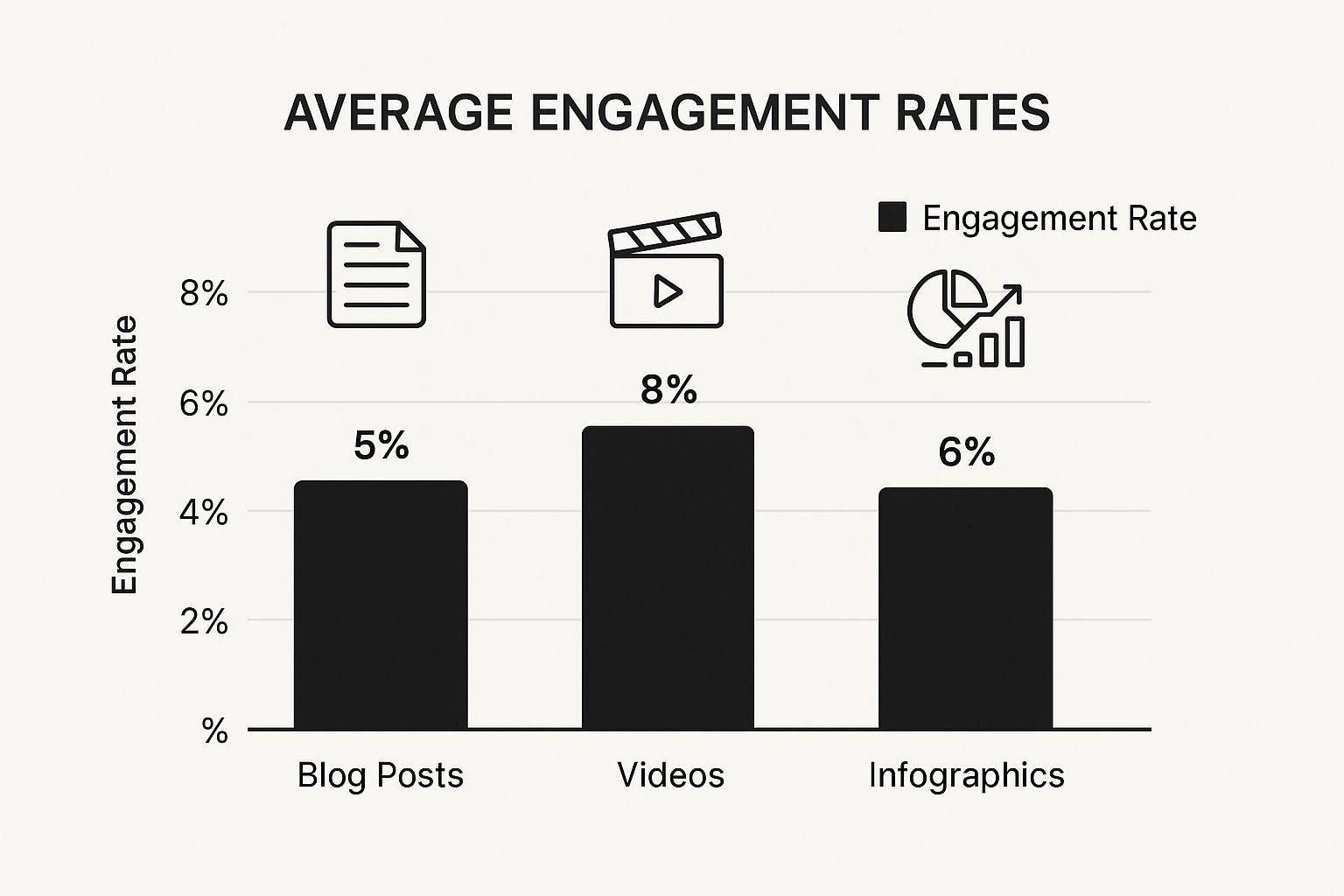An enterprise SEO strategy is a master plan for boosting the search visibility of massive, complex websites—we're talking sites with thousands, sometimes even millions, of pages. This isn't just your standard SEO on steroids. It’s a whole different game built around scalability, automation, and deep integration across the entire company to win in a hyper-competitive market.
What Exactly Is Enterprise SEO
Think about the difference between building a single custom home versus planning an entire city. Traditional SEO is like building that one beautiful house. A small, focused team handles every detail.
Enterprise SEO, on the other hand, is like large-scale urban planning. It demands a detailed blueprint, solid infrastructure, and the coordinated efforts of many different teams to make sure the whole digital "city" not only works but also grows and thrives.
This isn't just about optimizing a few more pages; it's a fundamental change in how you think and act. While a small business might zero in on a handful of important keywords, an enterprise is juggling thousands of product pages, multiple subdomains, different countries, and content that changes by the minute. Manual approaches just can't keep up with that kind of scale.
The Core Pillars of Enterprise SEO
To wrangle all this complexity, a winning strategy rests on three key pillars. These are the real differentiators that set it apart from smaller operations.
- Radical Scalability: At the enterprise level, everything you do has to work across thousands of pages without a hitch. This means creating page templates, generating content programmatically, and rolling out automated technical fixes site-wide. No room for one-off manual tweaks here.
- Intelligent Automation: You can't manually track keyword performance across a massive portfolio or build internal links based on user behavior. Automation is the only way. It frees up your experts to focus on big-picture strategy instead of getting bogged down in repetitive work.
- Cross-Departmental Collaboration: SEO can't live in a silo. It has to be woven into the fabric of the product, development, content, and marketing teams. Decisions about site structure or a new product launch need SEO input from day one.
At its heart, enterprise SEO is about building a predictable, repeatable system that drives organic growth without getting crushed by the website's sheer size. It turns SEO from a simple marketing task into a core business function.
Moving Beyond the Basics
This strategic approach tackles problems that smaller sites don't even think about. For example, a local business almost never has to worry about its crawl budget—the number of pages Google will crawl on a given day. But for an enterprise with millions of URLs, optimizing that budget is absolutely critical to get the most important pages indexed quickly.
Content governance also becomes a huge deal. Instead of one person creating content, you have dozens of people across different teams. An enterprise strategy sets up a clear system to maintain quality, stick to the brand voice, and follow SEO best practices no matter who is writing.
If you're new to the core ideas of search optimization, it's a good idea to learn more about what search engine optimization is and how it works. Getting that foundation right is essential before trying to scale up to the enterprise level, where both the stakes and the complexity are much, much higher.
Building Your Technical SEO Foundation

If your content is the engine driving your enterprise SEO efforts, then your technical setup is the chassis everything is built on. You can have the most powerful engine in the world, but if the frame is weak, it’s all going to fall apart. A shaky technical foundation will undermine even the most brilliant content, leading to indexing problems, a frustrating user experience, and a ton of wasted effort.
Think of your enterprise website like a massive, sprawling library with millions of books. If the layout is a maze, the signs are wrong, and some sections are completely blocked off, visitors—and search engine crawlers—will get lost and simply give up. Good technical SEO ensures every aisle is clearly marked and easy to navigate.
This is where your enterprise SEO strategy has to be surgical. We're not just fixing a few broken links here. We're designing a system that can handle enormous growth without collapsing under its own weight.
Mastering Crawl Budget Optimization
On a site with millions of pages, your crawl budget—the number of URLs Googlebot can and wants to crawl—is a finite and incredibly valuable resource. Every bit of it wasted on low-value pages, messy redirect chains, or duplicate content means your most important pages might get ignored.
Effective crawl budget management is all about being a good tour guide for search engine crawlers, pointing them directly to your best stuff. You have to be ruthless about telling them what to skip.
A study by Deloitte found that a mere 0.1-second improvement in mobile site speed can boost retail conversions by 8.4%. This shows just how much technical precision impacts the bottom line. Every millisecond counts.
A few key moves can make a huge difference:
- Refine your
robots.txtfile: Explicitly tell crawlers to stay away from unimportant areas like internal search results, filtered navigation pages, or staging environments. - Use canonical tags correctly: Don't let duplicate content water down your authority. Use canonicals to clearly point to the one true version of a page.
- Implement a clean URL structure: A logical, hierarchical URL structure helps crawlers instantly understand your site’s layout and how different pages relate to each other.
This isn’t about hiding content from users. It’s about resource management. By guiding crawlers efficiently, you ensure your new product pages and cornerstone articles get indexed and ranked much faster.
Architecting for Scalability and International Reach
A solid technical framework is also your best defense during complex projects like a site migration or global expansion. A poorly planned migration can be an absolute catastrophe, wiping out years of hard-earned SEO value practically overnight. A successful one demands flawless execution of redirects, URL mapping, and performance testing.
Going global adds another thick layer of complexity. Serving content to an international audience requires much more than just a simple translation.
- Hreflang Implementation: These tags are non-negotiable. They tell search engines which language and country version of a page to show to which user. Get them wrong, and you’ll be showing German content to users in Spain or creating massive duplicate content headaches.
- International URL Structure: You'll need to decide between using country-code top-level domains (ccTLDs like
.deor.fr), subdomains (de.yourstore.com), or subfolders (yourstore.com/de/). Each approach has different implications for authority and ease of management.
Visual assets are a huge piece of the technical puzzle, too. For a deep dive, you can learn how to optimize images for SEO to make sure they're helping, not hurting, your site's performance.
Ultimately, building this technical foundation is about preventing problems before they start. By establishing clear templates, smart workflows, and a clean site architecture, you eliminate technical debt. You create an infrastructure that empowers your content and product teams to execute your enterprise SEO strategy without anything holding them back.
How to Scale Your Content Engine

At the enterprise level, your content operation needs to run less like a small craft workshop and more like a high-output factory. You’re not just writing one-off articles anymore. The real goal is to build a scalable engine that consistently churns out massive volumes of high-quality, optimized content. This is the bedrock of any serious enterprise SEO strategy.
A small business can get by handwriting every blog post, but an enterprise managing tens of thousands of pages needs a system. It has to be repeatable, efficient, and capable of generating countless optimized pages without the quality tanking. The stakes couldn't be higher.
We all know the competition for attention is brutal. That’s why enterprises have to nail both their content and their technical game. The numbers don't lie: 75% of users never click past the first page of search results, and organic listings soak up around 70% of all clicks. It’s no wonder that 72% of SEO agencies say content creation is their most effective move to grab that prime digital real estate. If you want a deeper dive, check out these crucial SEO statistics on OuterBox.
Embracing Programmatic SEO
For data-rich enterprises, programmatic SEO is the ultimate cheat code for scaling. It’s all about using automated scripts and templates to generate thousands of unique pages directly from a database. Think of it like a mail merge, but instead of letters, you’re creating an army of web pages.
Zillow is the classic case study. They don’t have an army of writers creating a unique page for every address in America. Instead, they use a smart template that pulls in data for each property—price, square footage, neighborhood details—and automatically builds millions of hyper-targeted landing pages.
This strategy lets companies absolutely dominate long-tail keywords on a scale that would be a logistical nightmare to do manually. It’s a perfect fit for:
- E-commerce sites with enormous product catalogs.
- Real estate companies with endless property listings.
- Travel aggregators juggling data on flights, hotels, and rentals.
- Review websites like G2 that create comparison pages for thousands of software pairings.
Building Unbeatable Topical Authority
Volume alone isn't enough; an enterprise SEO strategy has to build deep topical authority. This means you stop chasing individual keywords and start owning entire subject areas. The best way to pull this off is with topic clusters.
A topic cluster is built around a central "pillar" page that covers a broad subject. This pillar then links out to dozens of "cluster" pages, each diving deep into a specific subtopic. This structure screams to search engines that you're a comprehensive, trustworthy source on the matter.
By creating an interconnected web of content, you’re not just ranking for one keyword; you're building a fortress of expertise that is incredibly difficult for competitors to overcome. This transforms your website into a go-to resource for a whole niche.
Establishing Content Governance and Workflows
With so many people and moving parts, a clear content governance plan is non-negotiable. This plan is the rulebook for your content factory, making sure every single piece meets your quality, brand, and SEO standards. For an operation of this size, figuring out how to scale content creation is the key to making the whole engine run smoothly.
Your governance plan should spell out:
- Roles and Responsibilities: Who comes up with ideas? Who drafts, edits, approves, and hits publish?
- Editorial Guidelines: What's our tone of voice? What are the style and formatting rules?
- SEO Best Practices: What are our standards for keyword placement, internal linking, and metadata?
Finally, you have to be smart about using AI. AI can be a fantastic assistant for brainstorming, outlining, or even roughing out a first draft. But—and this is a big but—every piece of AI-assisted content must be reviewed, fact-checked, and refined by a human expert. This ensures it meets Google's E-E-A-T (Experience, Expertise, Authoritativeness, Trustworthiness) standards. It’s the only way to learn https://copymasters.co/blog/how-to-scale-content-marketing without sacrificing the quality and authenticity your audience expects.
Weaving AI and Automation into Your Strategy
At the enterprise level, trying to manage thousands of pages and millions of data points by hand isn't just difficult—it's impossible. This is where AI and automation stop being a "nice-to-have" and become a core necessity. Integrating this technology is the only way to tame the complexity and unlock efficiencies that smaller operations can only dream of.
Think of AI not as a replacement for your SEO team, but as a powerful force multiplier. It takes on the soul-crushing, repetitive work—like monitoring a million-page site for technical errors or tracking endless keyword fluctuations. This frees up your human experts to focus on what they do best: high-impact strategic work that demands creativity and real-world business acumen.
This shift allows your enterprise SEO strategy to evolve from reactive fire-fighting to proactive, data-informed growth. Instead of just fixing what’s broken, your team can start predicting search trends and building personalized content experiences on a massive scale.
Automating the Day-to-Day SEO Grind
The quickest wins from AI and automation come from streamlining the foundational, everyday tasks. These are the areas where machines can simply handle the sheer volume of work better and faster than any human team ever could.
- Technical Monitoring: AI-powered crawlers can constantly patrol your entire website, instantly flagging issues like 404 errors, messy redirect chains, or crawl budget waste. This turns site health from a once-a-quarter audit into a real-time, always-on process.
- Keyword Portfolio Management: Forget manually tracking a few hundred keywords in a spreadsheet. Automation lets you monitor performance across tens of thousands of terms, spotting opportunities and threats the second they appear.
- Internal Link Analysis: Instead of guessing, AI tools can map your entire site architecture and pinpoint the most valuable internal linking opportunities, making sure SEO authority flows exactly where you need it most.
Automation transforms SEO from a list of manual chores into a scalable, intelligent system. By letting machines handle the grunt work, you empower your team to think bigger and focus on growth, not just maintenance.
To see this in action, let's compare the old way of doing things with the new, AI-powered approach.
Manual SEO Tasks vs AI-Powered Automation
This table breaks down how traditional SEO tasks get a major upgrade with AI, highlighting the benefits for a large-scale enterprise.
| SEO Task | Traditional Manual Approach | AI-Powered Enterprise Approach | Key Benefit |
|---|---|---|---|
| Technical Audits | A massive, time-consuming project done quarterly or annually. | Continuous, real-time monitoring and instant alerts for critical errors. | Proactive Problem Solving: Fix issues before they impact rankings. |
| Keyword Research | Manually pulling data from multiple tools and analyzing it in spreadsheets. | AI identifies opportunity gaps, predicts trends, and clusters thousands of keywords by intent. | Scalable Opportunity Discovery: Uncover hidden niches and emerging topics. |
| Content Creation | Human writers working from a brief, which is slow and hard to scale. | AI assists with outlines, data points, and first drafts, letting writers focus on quality and expertise. | Increased Velocity & Consistency: Produce quality content at a much faster pace. |
| Link Building | Manually prospecting for sites and sending outreach emails one by one. | AI identifies high-authority, relevant link prospects and can personalize outreach at scale. | Efficient Authority Building: Streamline one of the most resource-intensive SEO tasks. |
This comparison really drives home how AI doesn't just make things faster—it fundamentally changes what's possible at the enterprise level.
Advanced AI Applications That Create a Real Edge
Beyond the basics, AI unlocks more sophisticated strategies that can give you a serious competitive advantage. This is where an enterprise SEO program truly separates itself from the rest.
AI is brilliant at finding subtle patterns in enormous datasets, which is perfect for understanding user behavior and search intent. This allows for hyper-personalization, where content and product recommendations are dynamically adjusted for each visitor. The result? Much higher engagement and more conversions.
Different content types also perform differently. The infographic below shows the average engagement rates you can expect, which can help guide where you focus your efforts.

As you can see, video often drives the most engagement. AI can help you scale video production by analyzing your existing content and identifying which topics are most likely to succeed in a video format.
Finding the Right Balance: Automation and Human Expertise
Let's be clear: integrating AI isn't a "set it and forget it" solution. Google itself is already rewriting 60–70% of all meta descriptions, and a mind-boggling 25% of top-ranking pages don't even have one. This shows how much automation is already happening behind the scenes.
At the same time, 41% of marketers still say link building is the hardest part of their job. This highlights the central challenge for any enterprise: you have to balance AI’s incredible efficiency with the nuanced, human-led quality that search engines and users demand.
The smartest strategy uses AI to augment human expertise, not replace it. Relying too heavily on automated content without an expert review is a surefire way to produce low-quality, generic articles that will damage your brand’s authority. The goal is to let technology handle the scale and the number-crunching, while your team provides the final layer of strategy, creativity, and quality control.
To get started, it's worth exploring some of the best AI SEO tools available. Finding the right platforms for technical monitoring, content analysis, and strategic forecasting is the first step in building a truly modern enterprise SEO machine.
Measuring Success and Proving ROI

Let's be honest. At the enterprise level, nobody in the C-suite really cares about keyword rankings or a temporary traffic spike. Those are just directional signals. The real measure of a successful enterprise SEO strategy is its ability to deliver a clear, provable return on investment (ROI). Executive teams want to see exactly how organic search moves the needle on the bottom line.
It's time to move past the "vanity metrics" that look good on paper but don't mean much for the business. Our goal is to draw a straight line from every SEO initiative to a meaningful business outcome. That means tracking how your organic traffic turns into qualified leads, new sales, and a higher customer lifetime value (CLV).
Connecting SEO to Business Objectives
To prove your worth, you have to speak the language of the leadership team: revenue, market share, and growth. This means shifting your reporting away from technical jargon and focusing squarely on financial impact. You need to connect your day-to-day work directly to the company's biggest goals.
Start by figuring out what "success" actually means to each department.
- For the Sales Team: Success could be a measurable jump in marketing-qualified leads (MQLs) coming directly from organic search.
- For Product Teams: Maybe it’s driving more organic visitors to a new product page, leading to a bump in free trial sign-ups.
- For E-commerce: It’s simple—a direct increase in revenue that you can attribute to organic search.
When you align your key performance indicators (KPIs) with these business unit goals, SEO stops looking like a cost center and starts being recognized as a serious revenue driver.
Building Executive-Ready Dashboards
Generic reports overflowing with keyword data just won't cut it. Executives need a clean, high-level view of how the enterprise SEO strategy is stacking up against financial targets. This is where a well-designed dashboard is worth its weight in gold.
Using tools like Google Looker Studio or other enterprise platforms, you can build custom dashboards that tell a compelling story with data.
Your dashboard should be so clear that a non-SEO expert can grasp the main takeaways in 60 seconds. It needs to answer the big questions like, "How much revenue did organic generate last quarter?" and "What's the projected ROI on this new content initiative?"
This kind of reporting is absolutely crucial for securing—and keeping—your budget. The investment is already significant. Looking ahead to 2025, 55% of enterprise companies are putting over $20,000 per month into SEO. Why? Because 61% of B2B marketers now say organic traffic is their most vital inbound channel. You can dig into more of these B2B SEO trends and statistics on First Page Sage.
Advanced ROI Measurement Techniques
To get an even sharper picture of SEO's true impact, you can go beyond the standard last-click attribution model.
- Attribution Modeling: Don't let the default "last click" model steal credit. Explore linear or time-decay models to show how organic search assisted in a conversion, even if it wasn't the final touchpoint before the sale.
- Cohort Analysis: Group users who first found your site through organic search during a specific window. Then, track their behavior and spending over the long haul. This is the best way to calculate their true lifetime value and prove the long-term benefit of your work.
- Revenue Forecasting: Use historical data and market trends to build a solid forecast. Projecting the future revenue impact of a major initiative—like a site migration or a big content hub launch—helps you build a rock-solid business case to get the budget and resources you need.
Got Enterprise SEO Questions? We've Got Answers.
Running an enterprise SEO program means you’re constantly juggling complex questions that cut across different departments and long-term business goals. You need clear, direct answers to keep your strategy moving forward and get everyone on the same page. Let's tackle some of the most common hurdles enterprise SEO leaders face.
How Do I Get Other Departments to Actually Care About SEO?
The secret to getting buy-in is to stop talking about SEO. Seriously. Start speaking the language of the department you’re trying to win over. A successful enterprise SEO strategy is built on this kind of cross-functional support, not on forcing everyone to become a search expert.
When you sit down with other teams, frame your needs around what matters to them:
- For the Dev Team: Don't hand them a list of "SEO tasks." Instead, show them how technical fixes directly improve site speed, enhance the user experience, and create a more stable, efficient codebase. It’s about performance, not just rankings.
- For the Content Team: Explain how SEO insights can help them create content that actually gets seen by a massive, highly-motivated audience. It’s about building real brand authority and making sure their hard work pays off.
- For the C-Suite: Forget the technical jargon and focus on one thing: ROI. Use clear forecasts and custom dashboards to draw a straight line from every SEO initiative to revenue growth, more qualified leads, and a bigger slice of the market share.
What's the Single Biggest Mistake to Avoid?
Without a doubt, the most destructive mistake you can make in enterprise SEO is working in a silo. If your SEO team is an island, completely cut off from the product, development, and content teams, your strategy is dead in the water before you even start.
This kind of isolation creates constant, frustrating roadblocks. The dev team might roll out a beautiful site redesign that completely torpedoes your rankings overnight. Or the content team could publish brilliant articles that are functionally invisible to Google.
Success in enterprise SEO isn’t just about technical know-how; it's about deep integration. The most critical factor for sustainable growth is building shared goals and open lines of communication across every team. Without that, even the most brilliant strategy will ultimately fail.
How Long Until We See Real Results?
Results from an enterprise SEO strategy don't show up all at once; they arrive in waves. Think of it as a mix of quick wins that build momentum and long-term gains that deliver compounding growth. The key is to set realistic expectations with stakeholders from day one.
Here’s a practical timeline you can share:
- Quick Wins (1-3 Months): Technical fixes almost always deliver the fastest results. Things like optimizing your crawl budget, fixing broken redirect chains, or cleaning up messy metadata can produce a noticeable bump in rankings and traffic in just a few weeks.
- Meaningful Impact (6-12 Months): This is when your bigger strategic bets start to cash in. Building out comprehensive topic clusters, overhauling the site architecture, or launching a programmatic SEO play will begin to drive the kind of significant results that directly impact revenue.
- Compounding Growth (12+ Months): After the first year, a well-oiled strategy becomes a powerful growth engine. Your established topical authority and clean technical foundation create a flywheel effect, making it easier and faster to rank for competitive keywords and truly own your market.
Ready to turn your content into a predictable growth engine? Copy Masters delivers 30 search-optimized articles every month, meticulously crafted to outrank competitors and drive consistent traffic, leads, and sales. Learn more about our process.
- SaaS SEO Consulting for Predictable Growth - October 20, 2025
- What Is SEO Management Your Guide to Real Results - October 19, 2025
- A Guide to Quality Content for SEO That Ranks - October 18, 2025
